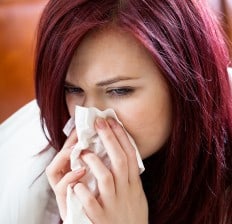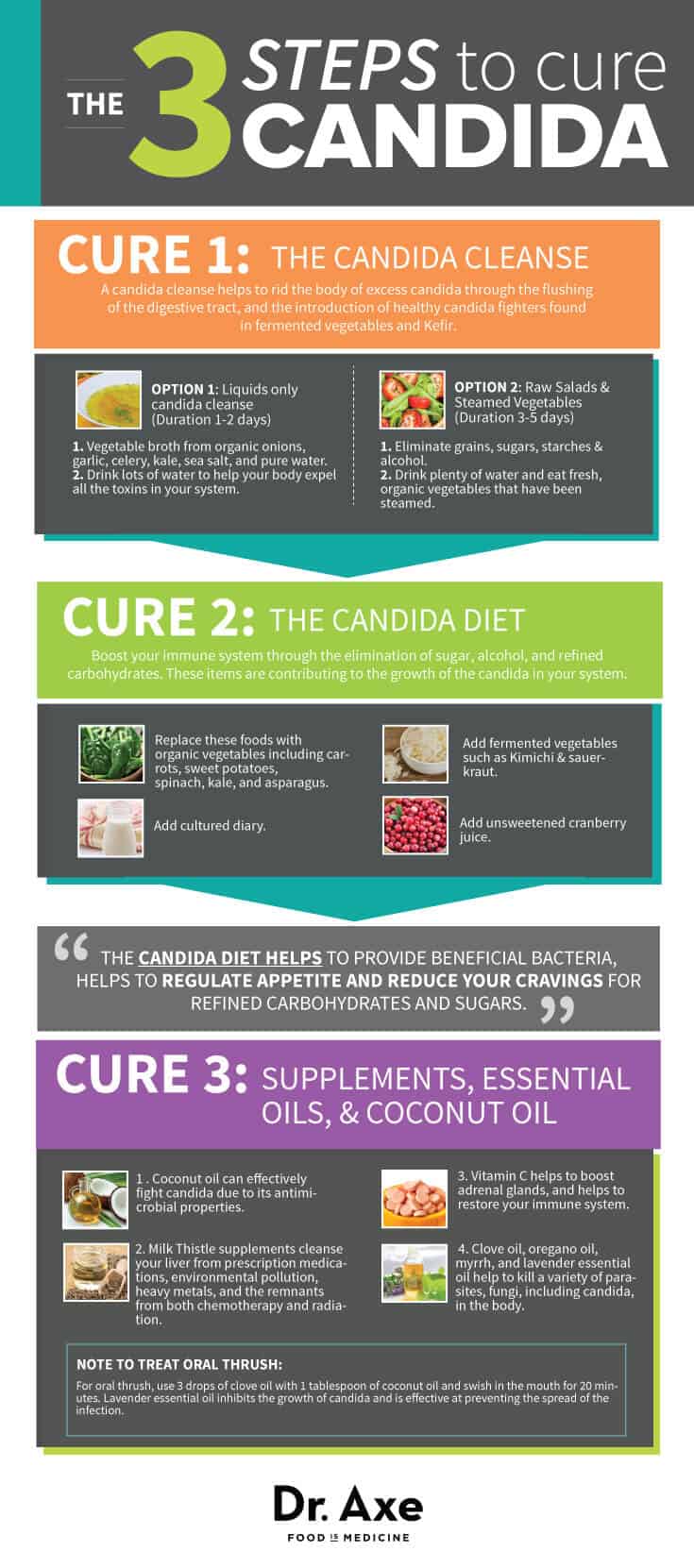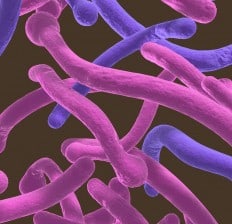Candida Symptoms
Do you ever experience any of these health issues?
- Exhaustion
- Cravings for sweets
- Bad breath
- White coat on tongue
- Brain fog
- Hormone imbalance
- Joint pain
- Loss of sex drive
- Chronic sinus and allergy issues
- Digestive problems (gas and bloating)
- Weak immune system
- UTI
If so, these are just some of the signs that you may have candida and in this article you will learn other candida symptoms along with what causes candida and the diet to cure candida for good.
What is candida?
Candida Albicans is the most common type of yeast infection found in the mouth, intestinal tract, and vagina and may affect skin and other mucous membranes. If the immune system is functioning optimally, this type of yeast infection is rarely serious. However, if the immune system is not functioning properly, the candida infection can migrate to other areas of the body, including the blood, and membranes around the heart or brain. (1)
Candida is a fungus that aids with nutrient absorption and digestion, when in proper levels in the body. When it overproduces, the typical candida symptoms may appear. In the digestive tract, left unchecked, it breaks down the walls of the intestinal lining and penetrates into the blood stream. This releases byproduct toxins, and other toxins from your system, causing leaky gut syndrome.
When you body’s natural pH balance is upset, the candida can grow out of control, creating a systemic problem. Good healthy bacteria, and a properly functioning immune system are essential when fighting this stubborn infection.
Candida Overgrowth Syndrome, or COS, is the term used when candida has grown out of control in your body. Make no mistake; this is a chronic health condition. Individuals that have never experienced a serious yeast infection can find they have developed new sensitivities, allergies or intolerances to a variety of foods. These foods include dairy, eggs, corn and gluten.
What Causes Candida Infections?
There are many possible causes of candida including a diet high in sugar, refined carbohydrates and alcohol that help yeast to grow. To add to that, I’ve described 6 other potential causes below.
– Broad-Spectrum Antibiotics
Sometimes, antibiotics are needed to fight a stubborn infection to kill the offending bacteria in your system. The problem with antibiotics and with overusing them is that they don’t just kill the bad bacteria; they kill the good ones too.
The good bacteria in your system are responsible for digestion, and keeping candida under control. After a long course (or multiple courses over a short period), antibiotics can make your body a literal breeding ground for candida.
– Birth Control Pills
Unlike antibiotics, birth control pills in and of themselves do not directly cause a yeast infection or candida overgrowth syndrome. However, when a woman has a diet high in refined sugars, and has had a course of antibiotics, birth control pills can adversely affect their body, leading to a candida infection.
Some women find that birth control pills seam to instigate yeast infections, and even long after the initial infection is gone, once they start taking the birth control pills again, candida can take root.
– Oral Corticosteroids
Individuals that treat their asthma with corticosteroid inhalants are at an increased risk of developing candida in the mouth, leading to systemic candida overgrowth.(2) It is imperative that individuals using corticosteroid inhalers for asthma follow the directions for swishing the mouth out after each use. If oral candidiasis is detected, can be treated with the gargling of coconut oil and a drop or two of essential clove oil.
– Cancer Treatments
According to the Department of Clinical Research at Merck Research Laboratories, candidiasis can become invasive in cancer patients and prevent a serious complication.(3) In this study, 1/3 of patients being treated for cancer, had “invasive” candidiasis. Chemotherapy and radiation can both work to kill cancerous cells and tumors; however, they also kill off the healthy bacteria that naturally fight candida.
– Diabetes
In a Type 1 or a Type 2 diabetic, sugar levels in the mouth, and other mucous membranes are traditionally higher than in an individual without diabetes. As candida is a type of yeast, and sugar feeds yeast, it is understandable that those with diabetes are at a greater risk for developing candida overgrowth syndrome.
– Weakened Immune System
Any individual with a weakened immune system is more likely to develop candida. This population includes infants, small children, the elderly, those diagnosed with HIV/AIDS (4), and other inflammatory and autoimmune conditions.
9 Candida Symptoms
Candida overgrowth can be difficult for a physician to diagnosis. This type of system yeast infection presents different ways, in different people. Below are 9 of the candida symptoms to watch for if you are concerned you have candida, or candida overgrowth syndrome.

1. Chronic Fatigue
If you have fatigue or exhaustion that you simply cannot shake, regardless of the number of hours you sleep, you may have Chronic Fatigue Syndrome. The disease is characterized by fatigue that lasts a minimum of 6 months, and is often accompanied by other symptoms including headaches, joint pain, difficulties with memory and concentration, and sore throat. (5)
Often one of the candida symptoms is chronic fatigue. While a candida infection is not the only cause of chronic fatigue syndrome, many physicians believe it heightens the risk of CFS.
 2. Mood Disorders
2. Mood Disorders
One of the reasons it can be difficult to diagnosis candida, is that so many of the candida symptoms are common to other conditions, including mood disorders. Individuals with candida overgrowth may experience dramatic mood swings, anxiety, irritability, depression, and even panic attacks.

3. Recurring Vaginal and Urinary Tract Infections
When an individual experiences recurring infections in the urinary tract or vagina, candida may be at the root of the problem. It is important to realize that candida can be sexually transmitted, and partners can spread it back and forth. For women, reduce the risk by avoiding tight-fitting underwear or pantyhose and avoid hot baths during an active infection. (6)

4. Oral Thrush
Oral Thrush is actually a yeast infection, caused by the same strain of candida that affects other mucous membranes, including the vagina. Most often caused by the use of prednisone or other oral corticosteroids as mentioned above.(7) Left untreated, it may spread through the body including the digestive tract, lungs, liver, and heart valves.
Oral candida is communicable; newborns can get thrush during birth, children can get it from sharing toys with other children, and adults can pass it back and forth through the saliva.(8)

5. Sinus Infections
As with many of these other candida symptoms, sinus infections are common today, and it can be difficult to pinpoint the root of the cause. Candida does affect the sinuses and can result in a persistent cough, post-nasal drip, an increase in congestion, seasonal allergies, and general flu-like symptoms. If you experience consistent problems with your sinuses, it is time to check for a candida infection!

6. Intestinal Distress
Ongoing intestinal distress is a sign you have a candida infection. Persistent flatulence, burping, bloating, constipation or diarrhea, and stomach cramps may be caused by a lack of healthy bacteria in your digestive tract.
When yeast overtakes the intestines, healthy bacteria are undermanned, and cannot fight off the infection alone. Many individuals experience dramatic relief of chronic intestinal distress when effectively treating a candida infection.

7. Brain Fog
Along with mood changes and chronic fatigue, brain fog is often overlooked as a sign of candida. However, candida overgrowth can cause a lack of focus, poor physical coordination, difficulty in concentrating on tasks, and poor memory.

8. Skin And Nail Fungal Infections
Athlete’s foot and fungus in the toenail are common yeast infections, which stem from the same breed of candida. Continued infections may be a sign that you have a systemic candida infection.

9. Hormonal Imbalance
Again, this is one of the signs of candida that presents in many other health conditions. However, it is important to recognize how an infection can cause early menopause, PMS, a low sex drive, migraines, endometriosis, water retention, mood swings, and an inability to lose unwanted pounds.
Whilst in the midst of candida overgrowth, your body becomes inflamed, causing the yeast to grow and spread beyond the digestive tract. One of the byproducts of candida actually can mimic estrogen, leading to a serious hormonal imbalance. (9)

Cure 1: The Candida Cleanse
The candida cleanse helps to rid the body of excess candida through the flushing of the digestive tract, and the introduction of healthy candida fighters found in fermented vegetables and Kefir. You really have 2 options for a cleanse – a liquids only cleanse, or a more gentle cleanse with food. You may also for the most thorough gut reboot, start with the step one cleanse and then move to the step two cleanse. The whole process will set the stage for starting the Candida Diet as well!
Step One: Liquids Only Candida Cleanse: Duration 1-2 Days
Start by making a vegetable broth from organic onions, garlic, celery, kale, sea salt, and pure water. Let simmer and strain. Discard the vegetables and refrigerate the broth.
Throughout the day, sip on warm broth; it is imperative that you drink lots of water to help your body expel all the toxins in your system.This is not a long-term cleanse, however, it can be repeated as needed every few weeks. It can also be used as a jumpstart to the food cleanse below.
Step Two: Raw Salads And Steamed Vegetables: Duration 3-5 Days
By eliminating grains, sugars, starches and alcohol from your diet for 3 to 5 days, you can make great headway in your fight against candida overgrowth. During this time, eat raw salads made from leafy greens, and topped with just a bit of coconut oil and apple cider vinegar (or lemon juice).
You can also eat fresh, organic vegetables that have been steamed. Keep away from any starchy vegetables including carrots, radishes, beets, sweet potatoes, and white potatoes. These contribute to sugar levels, and will feed the candida. Continue to drink plenty of pure water, a minimum of 72 ounces per day, to help flush the candida and byproducts from your system.
During either of the candida cleanses above, you can use bentonite clay to help surround the toxins and efficiently remove them from your system.
Cure 2: The Candida Diet
This is not a diet to just discourage candida, it is the diet to help you rid your body of candida! This is also a great next step if you have already started with the candida cleanse!
1. The first step of the diet is to boost your immune system through the elimination of sugar, alcohol, and refined carbohydrates. These items are contributing to the growth of the candida in your system.
2. Step two is to replace these foods with organic vegetables including carrots, sweet potatoes, spinach, kale, and asparagus.
3. Step 3, add cultured dairy, preferably goat milk Kefir to you’re your body good probiotics that can effectively kill the candida in your system. Kimchi and sauerkraut are good additions to your diet as well as unsweetened cranberry juice as it creates an acidic environment that makes it difficult for candida to thrive.
Fermented vegetables contain microflora that helps to protect the intestines. Regular consumption can help improve the immune system, making the body less hospitable for candida. Begin with ½ cup a day of sauerkraut, Kimchi, or other fermented vegetables as part of a new eating plan dedicated to bringing your body back into a healthy balance.
The candida diet helps to provide beneficial bacteria, helps to regulate appetite and reduce your cravings for refined carbohydrates and sugars.
Cure 3: Supplements, Essential Oils, And Coconut Oil
Research shows that candida albicans, the strain of candida that leads to systemic candida overgrowth is often resistant to both fluconazole and itraconazole, the drugs most often prescribed for candida.
1. Coconut oil can effectively fight candida due to its antimicrobial properties.(10) The combination of lauric acid and caprylic acid found in coconut oil , kills off harmful candida through both ingestion, and topical application.
2. Milk Thistle supplements help to cleanse your liver from prescription medications (steroids, birth control, antibiotics, as well as others), environmental pollution, heavy metals, and the remnants from both chemotherapy and radiation.
As mentioned above, some prescription medications, and cancer treatments can lead to candida overgrowth. Milk thistle, along with the candida diet, can help your body recover, and create an environment where candida ceases to thrive.
3. Vitamin C helps to boost adrenal glands, and helps to restore your immune system. I recommend 1000 mg of Vitamin C twice per day.
4. Clove oil, oregano oil and myrrh essential oil help to kill a variety of parasites, fungi, including candida, in the body. By adding a couple of drops of clove oil mixed with coconut oil during your cleanse, you can help to kill off the offending candida. However these essential oils are powerful and should only be taken internally for 10 days or less and it’s best to work with your natural doctor as well.
NOTE: For oral thrush, use 3 drops of clove oil with 1 tablespoon of coconut oil and swish in the mouth for 20 minutes. Lavender essential oil inhibits the growth of candida and is effective at preventing the spread of the infection. (11)

Candida Die-Off Symptoms You May Experience
Rapidly killing off candida in your body creates a metabolic reaction that releases over 70 different toxins into your body. Symptoms that the candida cleanse and the candida diet are working include:
- Impaired brain function
- Headache
- Fatigue
- Dizziness
- Intestinal distress including bloating, gas, constipation, nausea
- Sweating and fever
- Sinus infection
- Skin breakouts (not limited to face)
- Typical flu-like symptoms
- Typically clear up in 7 to 10 days.
When you start experiencing the candida die-off symptoms, rejoice! The candida is leaving your body, and within just a few weeks, you will notice an increase in energy and focus, as well as relief from other symptoms you have experienced.
What Now?
After your symptoms have subsided and you have completed the cleanse and the diet, you should continue eating a diet that is high in protein and high-fiber vegetables, and limit starchy vegetables, grains, fruits and sugar. Continue with fermented vegetables and Kefir to help your body stay in balance, and keep the candida at bay!
